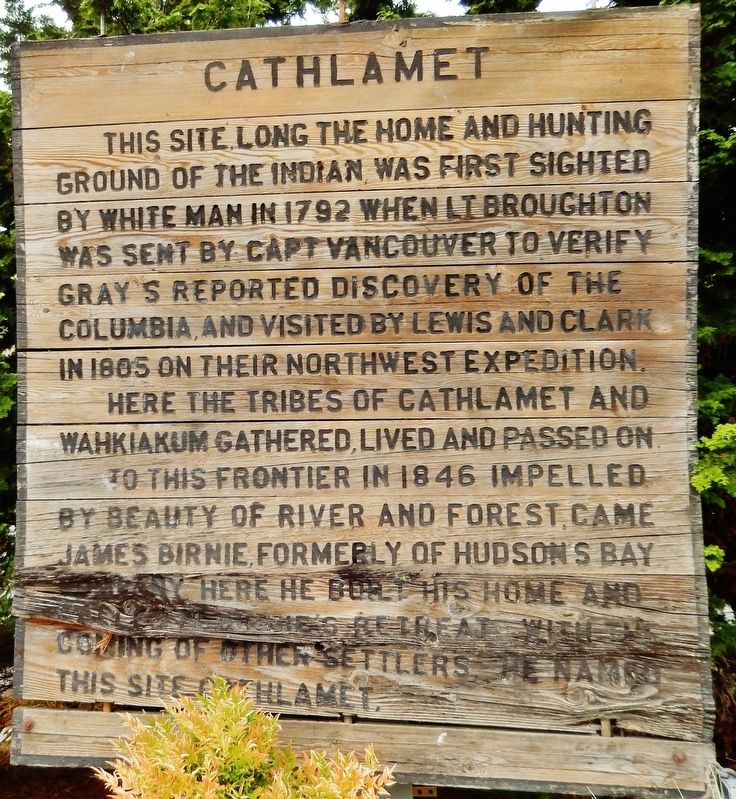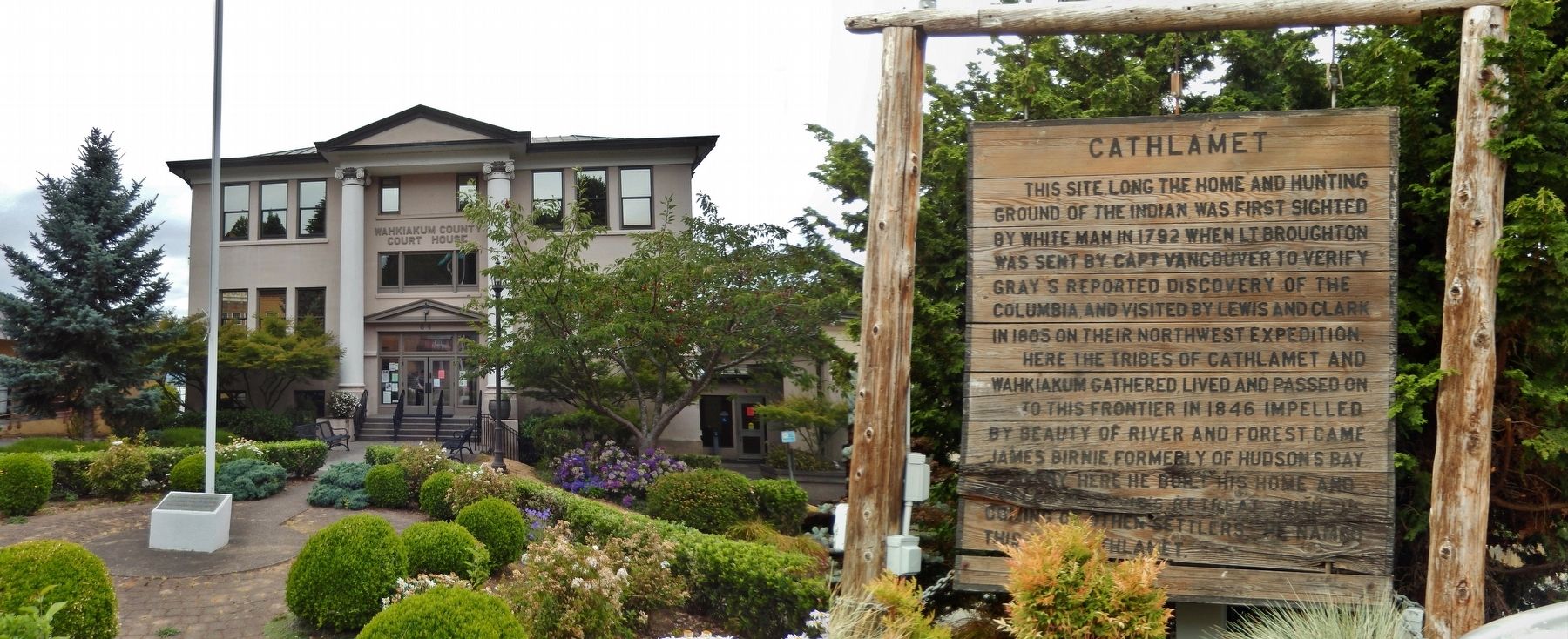Cathlamet in Wahkiakum County, Washington — The American West (Northwest)
Cathlamet
This site, long the home and hunting ground of the Indian, was first sighted by white man in 1792 when Lt. Broughton was sent by Capt. Vancouver to verify the Gray’s reported discovery of the Columbia, and visited by Lewis and Clark in 1805 on their Northwest Expedition.
Here the tribes of Cathlamet and Wahkiakum gathered, lived and passed on. To this frontier in 1846, impelled by beauty of river and forest, came James Birnie, formerly of Hudson’s Bay Company. Here he built his home and called it Birnie’s retreat. With the coming of other settlers, he named this site Cathlamet.
Topics. This historical marker is listed in these topic lists: Exploration • Native Americans • Settlements & Settlers • Waterways & Vessels. A significant historical year for this entry is 1792.
Location. 46° 12.166′ N, 123° 23.069′ W. Marker is in Cathlamet, Washington, in Wahkiakum County. Marker is on Main Street (Washington Route 409) south of Butler Street, on the right when traveling south. Marker is located on the front grounds of the Wahkiakum County Courthouse, in a small triangular plaza near the sidewalk and parking lot entrance. Touch for map. Marker is at or near this postal address: 64 Main Street, Cathlamet WA 98612, United States of America. Touch for directions.
Other nearby markers. At least 3 other markers are within 15 miles of this marker, measured as the crow flies. "Captain" John West and Westport, Oregon (approx. 3.3 miles away in Oregon); Ahlberg Park (approx. 14.1 miles away); Grays River Covered Bridge (approx. 14.1 miles away).
More about this marker. Marker is a large wooden "billboard-style" presentation. The wood is significantly weathered and somewhat difficult to read.
Also see . . .
1. History of Cathlamet.
Before the Town of Cathlamet came in to existence, the area on which it stands today was a Native American village occupied by the Wahkiakum tribe. The name “Cathlamet” is said to have come from the local Chinookan language spoken by the tribe that refers to a “rocky stretch of river channel”. Established as a trading post by James Birnie in 1846, it was incorporated on February 4, 1907. Cathlamet's docks once bustled with the sounds and smells of the commercial fishing, canneries and logging industry that were the backbone of the local economy. Today, the docks are still used by small fishing companies, tugboat operations and recreational boaters. (Submitted on April 19, 2018, by Cosmos Mariner of Cape Canaveral, Florida.)
2. Wahkiakum County History.
In May, 1792, American fur trader Robert Gray became the first non-Indian to enter the Columbia River. He sailed upriver some 15 miles to the shallow bay on the north
shore at the western edge of Wahkiakum territory that is now named for him. It was Gray who named the river "Columbia" (for his ship, the Columbia Rediviva); the Wahkiakums and other Chinookan speakers called it "Wimahl" (Big River). (Submitted on April 19, 2018, by Cosmos Mariner of Cape Canaveral, Florida.)
3. Cathlamet History.
James Birnie and his wife, Charlotte, brought their ten children to the village of Cathlamet in 1846. It was here that Birnie established a trading post called Birnie's Retreat. Birnie's Retreat soon became a thriving business trading furs, fish and other foods to the river travelers on their way to Astoria. At the time, there were still between three hundred and four hundred Native Americans still inhabiting the village. Charlotte Birnie was of Native American heritage being half Kootenai and half French Canadian and this heritage contributed to good relations with the local tribe who were responsible for much of what the Birnie's traded. (Submitted on April 19, 2018, by Cosmos Mariner of Cape Canaveral, Florida.)
Credits. This page was last revised on April 19, 2018. It was originally submitted on April 19, 2018, by Cosmos Mariner of Cape Canaveral, Florida. This page has been viewed 252 times since then and 19 times this year. Photos: 1, 2. submitted on April 19, 2018, by Cosmos Mariner of Cape Canaveral, Florida. • Andrew Ruppenstein was the editor who published this page.

